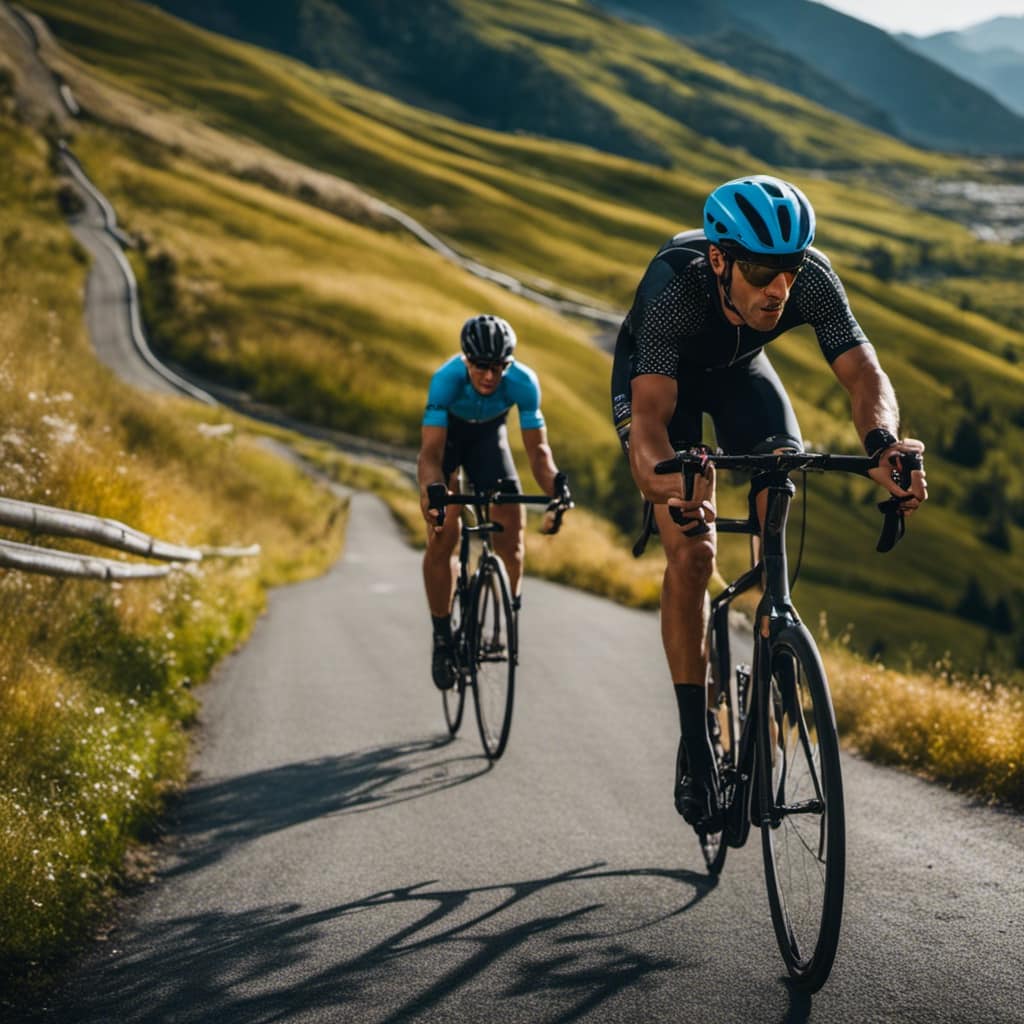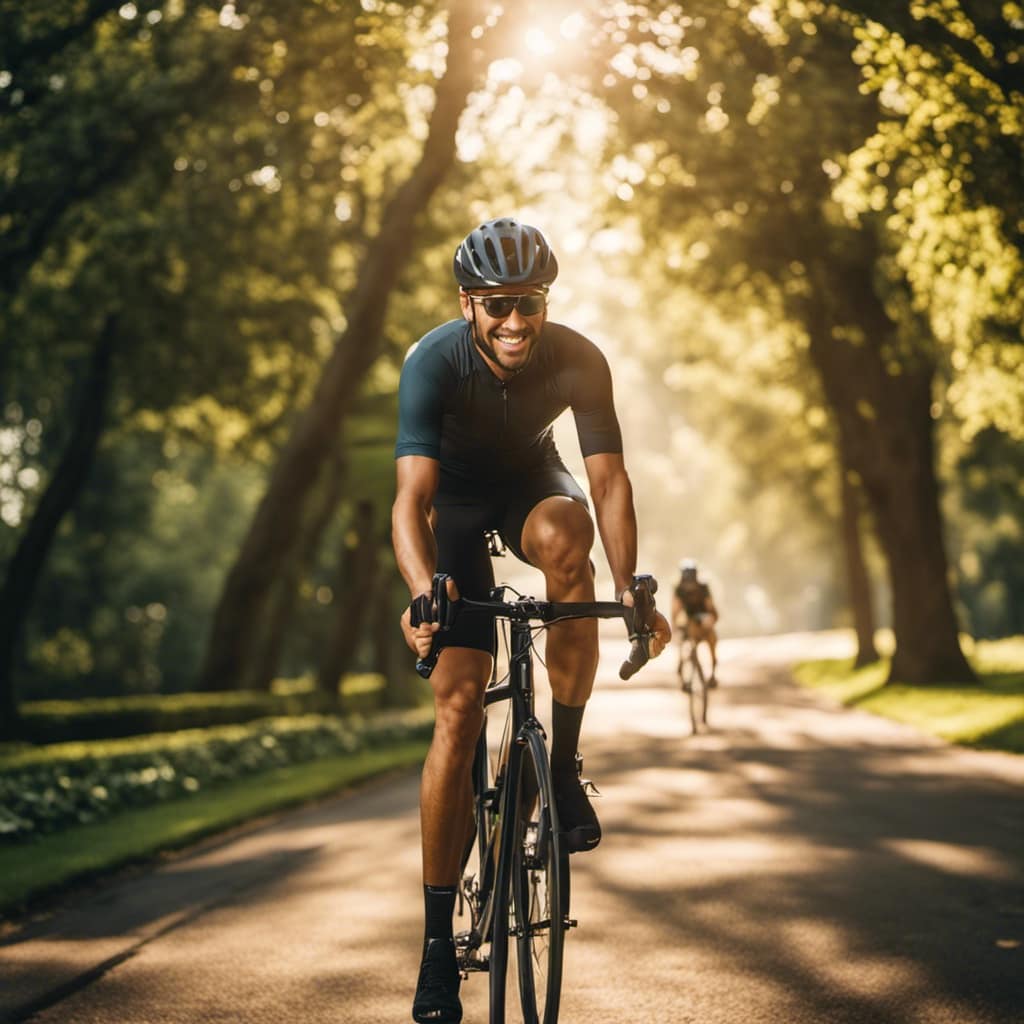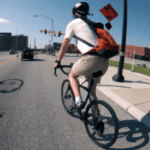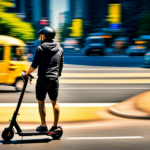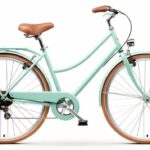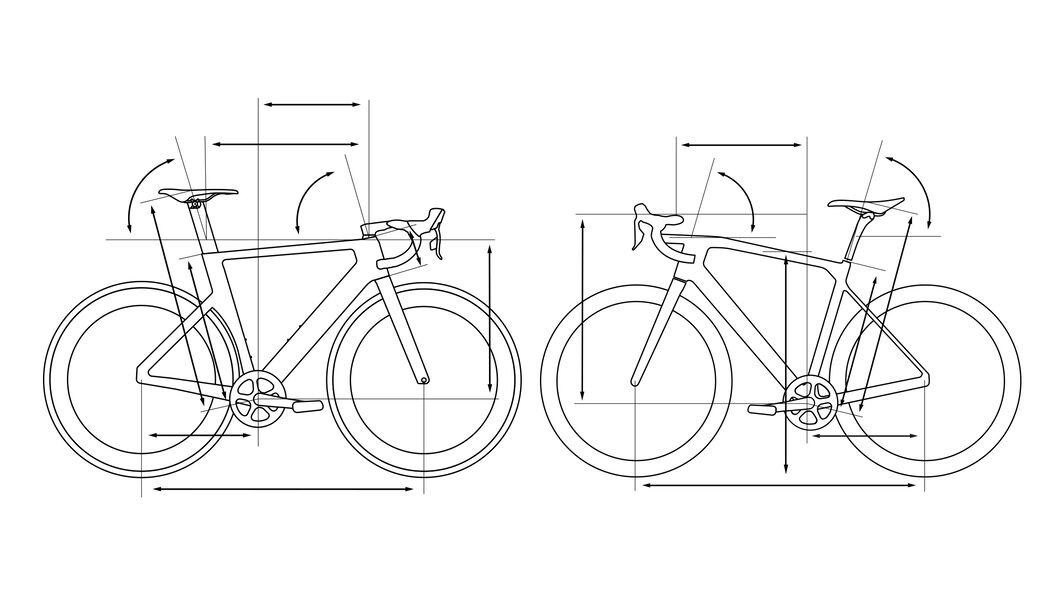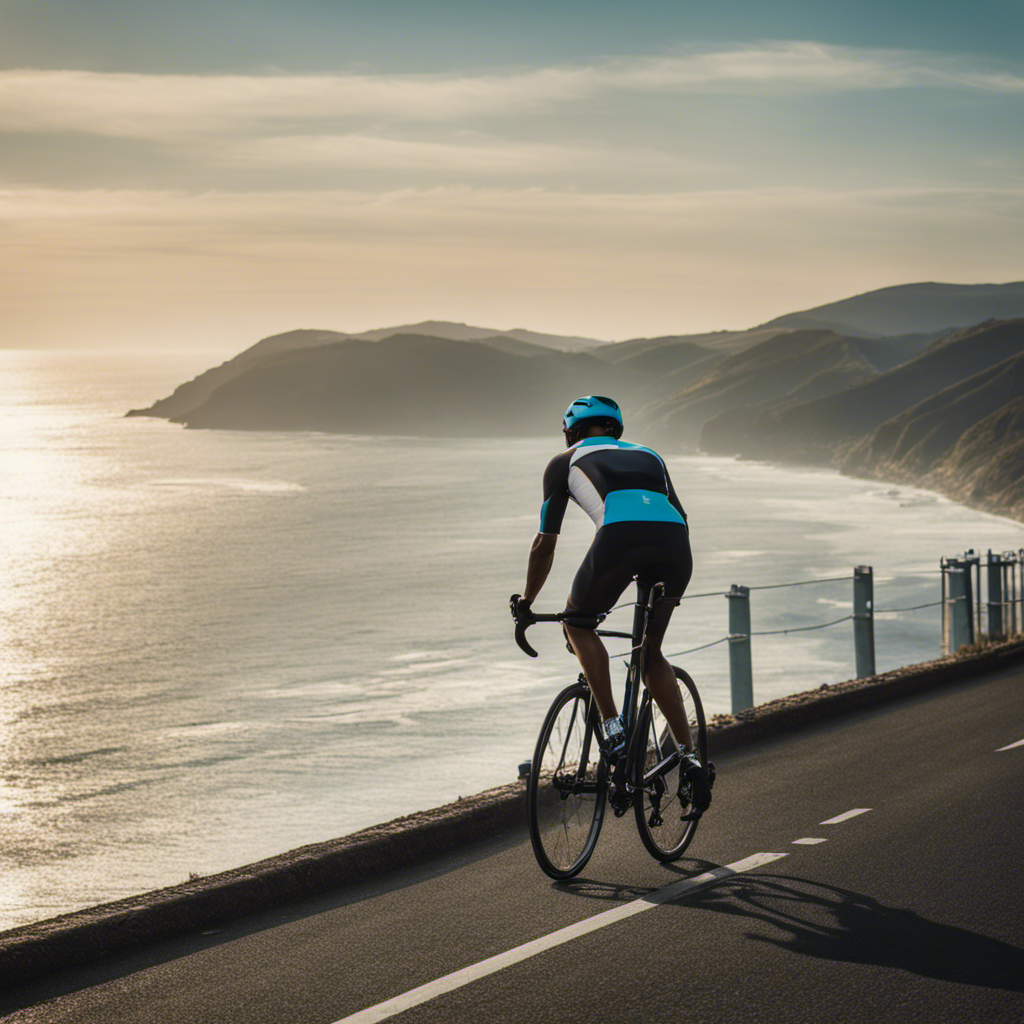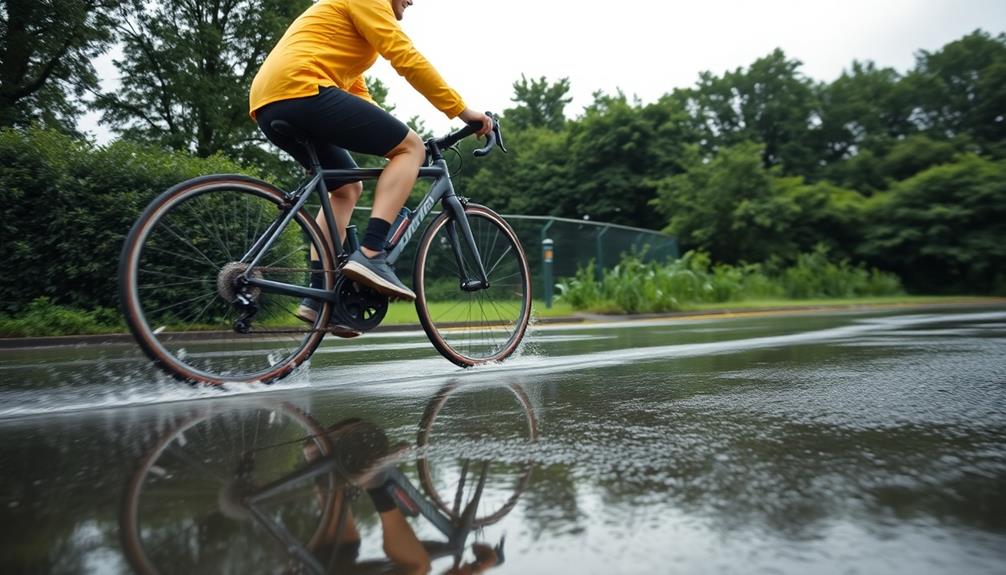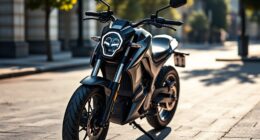
Liberate yourselves, fellow urban adventurers! Join us as we embark on a journey to conquer the bustling city streets on our trusty hybrid bikes.
In this guide, we’ll arm you with the knowledge and skills needed to navigate traffic with confidence. From planning routes to utilizing bike lanes, we’ll show you how to assert your presence, respect others, and stay safe amidst the chaos.
So gear up, strap on your helmets, and let’s ride into the city’s embrace together!
Key Takeaways
- Use online maps designed for cyclists to find bike-friendly routes
- Familiarize yourself with road signs and signals
- Wear reflective gear for nighttime visibility
- Use hand signals to communicate your intentions
Planning Your Route
We’ll start by mapping out our journey to ensure a smooth ride through the city streets.

When riding a hybrid bike in traffic, finding bike-friendly routes and avoiding high traffic areas are crucial for a liberating experience. To discover bike-friendly routes, consider using online maps specifically designed for cyclists. These maps often highlight dedicated bike lanes, shared paths, and low-traffic streets. Additionally, seek out local cycling forums or groups for recommendations on the best routes to take.
When planning your route, it’s essential to avoid high traffic areas. Look for alternative roads that may be less congested, even if they add a few extra minutes to your journey. By carefully selecting your route and avoiding heavy traffic, you can enjoy a safer and more enjoyable ride through the city streets.
Understanding Traffic Laws
Now let’s talk about understanding traffic laws, which is crucial for riding a hybrid bike in traffic.
Knowing and obeying road signs and signals is essential to ensure your safety and the safety of others on the road.

Understanding right of way rules will help you navigate intersections and avoid potential accidents.
Let’s dive into these points to help you become a confident and law-abiding cyclist in city streets.
Road Signs and Signals
One of the most important things to remember when riding a hybrid bike in traffic is to familiarize ourselves with the road signs and signals.
These signs and signals play a crucial role in ensuring our safety and the smooth flow of traffic.

Road markings, such as arrows, crosswalks, and bike lanes, provide valuable information about the designated paths for cyclists and pedestrians.
Understanding these markings allows us to navigate the streets confidently and make informed decisions.
Additionally, traffic signals, including stoplights and yield signs, dictate the right of way at intersections.
Knowing when to stop, yield, or proceed can prevent accidents and keep us and others safe.

Now that we understand the significance of road signs and signals, let’s move on to discussing the concept of right of way.
Right of Way
Understanding the rules of right of way while riding a hybrid bike in traffic is essential for ensuring our safety and navigating the streets effectively. As responsible riders, we must be familiar with the traffic laws that dictate who’s the right of way in different situations.
Here are two important points to consider:
-
Intersections: When approaching an intersection, we need to yield the right of way to any pedestrians who are crossing the street. It’s our duty to slow down and allow them to safely reach the other side.

-
Turning: When making a turn, we must yield to any vehicles, including bicycles, that are continuing straight. This ensures a smooth and safe flow of traffic and prevents potential accidents.
Wearing Visible Clothing
When it comes to riding a hybrid bike in traffic, wearing visible clothing is crucial for our safety. Reflective gear plays a significant role in making us more visible to drivers, especially in low-light conditions.
Additionally, choosing bright colors for our clothing can help increase our visibility during the day. Safety vests and bands are also essential accessories that can further enhance our visibility and ensure a safer ride.
Reflective Gear Importance
We always make sure to wear reflective gear when riding our hybrid bikes in traffic. Reflective accessories are essential for nighttime visibility, ensuring that we’re visible to motorists and pedestrians alike.

Here are two reasons why wearing visible clothing is important:
-
Increased visibility: Reflective gear, such as vests, jackets, and ankle bands, contain reflective materials that bounce back light from car headlights, making us more visible in low light conditions. This greatly reduces the risk of accidents by allowing drivers to see us from a distance.
-
Safety in traffic: Wearing visible clothing helps us stand out amidst the bustling city streets. This is particularly important when navigating through heavy traffic, as it alerts drivers to our presence and helps prevent collisions. The bright colors and reflective elements catch the attention of drivers, allowing them to adjust their course accordingly.
Bright Colors for Visibility
Two important factors to consider when riding in traffic are wearing bright colors and using reflective accessories.

Wearing high visibility accessories and neon colored gear can greatly increase your visibility on the road, ensuring that other road users can easily see you. Bright colors such as neon yellow, orange, or green stand out against the background, making you more noticeable, especially in low light conditions.
Reflective accessories, such as reflective strips on your clothing or reflective bands on your bike, can also enhance your visibility by reflecting light back to its source. This is particularly important when riding at night or in areas with poor lighting.
Safety Vests and Bands
We should always prioritize our safety while riding in traffic, and one effective way to do so is by wearing safety vests and bands to ensure our visibility to other road users. Safety vests and reflective bands are essential accessories for any cyclist navigating city streets.
Here are some reasons why wearing visible clothing is crucial for our safety:

-
Enhanced Visibility: Safety vests and reflective bands make us more visible to drivers, especially in low-light conditions or at night.
-
Reduced Risk of Accidents: By wearing these reflective accessories, we reduce the chances of accidents caused by drivers not seeing us in time.
-
Increased Awareness: Reflective bands on our arms and legs catch drivers’ attention, helping them become more aware of our presence.
-
Improved Safety: Safety vests with bright colors and reflective strips allow drivers to spot us from a distance, giving them ample time to react.

Using Hand Signals
As we navigate through busy city streets, it’s important to use hand signals to communicate our intentions to other road users. Hand signals are a universal language that allows us to convey our next move, ensuring a safer cycling experience.
When turning left, extend your left arm straight out to the side. For a right turn, bend your left arm at the elbow and point your hand upwards. To indicate stopping or slowing down, extend your left arm downwards with the palm facing backwards.
By using these hand signals, we can communicate our intentions clearly and effectively, allowing drivers, pedestrians, and fellow cyclists to anticipate our actions.
Maintaining Safety Distance
And, as cyclists, we must also prioritize maintaining a safe distance between ourselves and other vehicles on the road. Ensuring a safe distance not only reduces the risk of collisions, but also gives us more time to react to sudden changes in traffic flow.

To maintain a safe distance, consider the following:
-
Anticipate traffic flow:
-
Observe the speed and movement of surrounding vehicles to predict any potential hazards.
-
Look out for signs of congestion or erratic driving behavior that may require you to create more space.

-
Keep a buffer zone:
-
Maintain a distance of at least three feet from parked cars to avoid getting ‘doored.’
-
Stay a safe distance behind larger vehicles, as they may have limited visibility.
Respecting Vehicles and Pedestrians
To ensure a safe and harmonious experience on the road, it’s important for cyclists to respect the vehicles and pedestrians they encounter. Pedestrian awareness and vehicle interaction are crucial aspects of riding a hybrid bike in traffic.

As cyclists, we must always be mindful of pedestrians and their right of way. This means slowing down or stopping when necessary, especially at crosswalks and intersections. By doing so, we not only prevent accidents but also contribute to a positive image of cyclists in the community.
Additionally, it’s essential to interact responsibly with vehicles on the road. This includes obeying traffic signals, using hand signals to indicate turns, and maintaining a visible presence on the road. By respecting vehicles and pedestrians, we can create a safer and more inclusive environment for everyone on the streets.
Utilizing Bike Lanes
Navigating through busy city streets on a hybrid bike, we can maximize our safety by utilizing bike lanes effectively. Bike lanes provide a designated space for cyclists, allowing us to ride without impeding vehicle traffic. To ensure a smooth and safe experience, it’s important to follow bike lane etiquette and navigate busy intersections with caution. Here are some tips to help us make the most of bike lanes:
- Always ride in the same direction as traffic, staying to the right side of the bike lane.
- Signal your intentions to other road users, using hand signals to indicate turns or lane changes.
- Be cautious when crossing intersections, checking for oncoming traffic and pedestrians before proceeding.
By following these guidelines, we can navigate bike lanes confidently and safely.

However, it’s crucial to remember that being aware of our surroundings goes beyond just utilizing bike lanes effectively. Let’s now explore the importance of staying alert and attentive in the next section.
Being Aware of Surroundings
Are we actively scanning our surroundings while riding our hybrid bike in traffic? Situational awareness is key when it comes to navigating city streets on a bike. As riders, we must be constantly aware of our surroundings to anticipate potential hazards and react accordingly. By practicing defensive riding techniques, we can minimize the risks and ensure a safe journey. Here’s a table to help us understand the importance of situational awareness and some defensive riding techniques:
| Situational Awareness | Defensive Riding Techniques |
|---|---|
| Keep your eyes on the road ahead | Maintain a safe distance from vehicles |
| Check your mirrors regularly | Signal your intentions clearly |
| Be mindful of blind spots | Avoid distractions, such as using a phone |
| Watch for pedestrians and other cyclists | Obey traffic laws and signals |
| Stay alert to changing road conditions | Ride predictably and confidently |
Conclusion
In conclusion, navigating city streets on a hybrid bike requires careful planning, knowledge of traffic laws, and a commitment to safety. By following these guidelines and utilizing bike lanes, riders can confidently conquer the streets while respecting both vehicles and pedestrians.
Remember, being aware of your surroundings is key to a successful and safe journey. So gear up, stay visible, and let your hybrid bike take you on an exciting adventure through the bustling cityscape.

